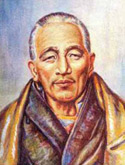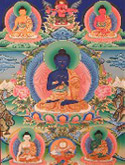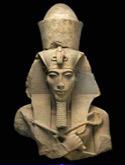Astrologers agree that the Moon is closely associated with form life, memory and emotion; these dimensions of human experience are basic to our understanding of the role of the Moon in both traditional and esoteric astrology. Seeming differences between the two astrological orientations actually derive from their similarities: esoteric astrology acknowledges traditional concepts concerning the Moon, but regards them from a cause-and-effect perspective and in terms of the energetic dynamics to which they refer. The Moon’s many rulerships (over biological life and growth, emotional expression and moods, our personal and collective pasts and psyches, etc.) pivot about a central axis, which is our understanding of the nature of form, itself; esoteric astrology proceeds from the assumption that form on any level is primarily the dense expression of underlying force.
Earth is esoterically considered a school or laboratory for the incarnating soul. The soul draws substance to itself in order to build a body of manifestation on Earth; substance corresponds to, resonates with, and reveals the levels of consciousness potentially available to any organism. The visible human being operates through a physical body which is dynamized by subtle interpenetrating fields of energy known as the etheric, astral and mental bodies; each of these vehicles is characterized by the particular quality of the substance of which it is formed, and together they comprise the personality. We are used to thinking of substance as something tangible in physical terms, but what is less completely understood is that substance is energy “captured” at various stages of refinement or expression; its origin is in the world of forces. The physical body is the result or effect of preceding energetic causes whose ultimate source is Spirit, and the link between Spirit and personality is the soul. The relationship between the subtle and physical bodies is thus that of Spirit-soul-substance, and that paradigm describes a solar system as truly as it does a human being; each forms around a central spiritual core or idea, and that spark of Godhead eventually expresses in form.
Manifestation always implies density or a convergence of forces at a particular level. Esoteric astrology concerns itself with the soul’s experience and intentions, and thus it involves the subject of karma. Rebirth is a postulate of the esoteric studies set forth by Master D. K. through Alice A. Bailey, but it is not necessary for individuals to accept that teaching at face value; what is past can refer to any stratum of incorporated experience, from the most recent to the most remote (since time is a dimension the soul transcends). What is important in terms of growth and spiritual evolution is an understanding of the energies which have gone into making us who we are, and the logical outcomes to which such energies might lead. Experientially, we are reborn with each ascending turn we take on the spiral of awareness, and whether that turn occurred in conjunction with the Civil War or following an argument with one’s spouse yesterday is not ultimately the point; however, the growth of the human spirit tends to follow archetypal patterns which can be fruitfully explored through a study of planetary symbolism in the horoscope.
In a very real sense the entire horoscope represents one’s karma, or the self-sown harvest of the soul as it undertakes individual experience, perceiving and acting through its personality-vehicle. The birthchart provides ways of understanding the soul’s objectives at any given point on the space-time continuum. We know that the birthchart constantly evolves via progressions, directions and transits, externalizing during the soul’s appearance or incarnation. It is well known to astrologers that birthcharts seem to hint at ongoing life even after their “owners” have died; for example, the charts of public figures show heavy activity in the Midheaven (the point of public recognition) each time books are published about them. This is an example of energetic reverberation throughout the planes of existence, and is akin to the relay of whispers in an echo chamber. The entire harmonic spectrum of the soul’s experience is theoretically accessible through the birthchart, which is holographic; but the most prominent aspects, signs and placements in our charts seek to point us in specific directions according to our present levels of learning. The chart’s overall pattern and emphases show us how to proceed according to the soul’s plan, thus consciously uniting soul and personality.
The birthchart is an index to the energies available to us. Those energies, translated into earth-plane experience, tend to result in events embodying archetypal or mythological themes. The archetype, at least in the Jungian sense in which I use that term, is neither a form nor an inherited idea, but an innate tendency to experience some aspect of life in a certain way. The archetype is primordial, preverbal and cross-cultural, and represents a structural pattern of symbol formation within the psyche which can be clothed in the garb of any nationality, social group or tradition. The archetype is the basis of images and motifs which appear universally in myths, dreams and fantasy, conditioning one’s individual experience of life. For example, one meets one’s own mother within the setting of a particular country, hometown and social milieu; but behind her stands The Great Mother, the universal experience of motherhood as a dynamic force. This Mother is both nurturing and devouring, and through her — glimpsed or dimly sensed beneath the temporal skin of the earthly mother — we approach the realm of the Underworld, that vast collective unconscious whence all life begins and ends in undifferentiated wholeness. No wonder we fear her!
Each human experience is substructured by an archetype. The archtype of the Divine Child is manifested in every world teacher; the archetype of the Wise Old Man or Senex is embodied in the elder statesman or priest; the Animus and Anima represent our collective experience of polarity expressed as man and woman, respectively, and we meet them every day behind the faces of our associates and partners. The planets, too, point to archetypal or universal themes which undergird our particular circumstances, and it is to this psychological fact that the astrology of karma refers. Relationships between planets in our birthcharts represent inner dialogues between forces that are more-than-human, and through them we can find ourselves within a larger setting.
Each archetype carries within it the fullness of experience, which is why The Great Mother both nurtures and devours. The realm of the archetypes is the realm of paradox, of both/and rather than either/or. When one end or extreme of an archetypal range of experience is constellated, so is its opposite number; but in humanity’s present stage of development, we can only hold the complete archetype in consciousness for brief periods of time, if at all. Usually, one end of the archetype is “owned” and the other is projected onto individuals or groups, or buried in the unconscious. Both ends of the spectrum are valid and authentic, although generally only one represents the conscious position. This is why the saint should not be completely trusted, and why the sinner can have a heart of gold. In a horoscope, an aspect between planets represents potential interactions embracing an entire spectrum of possibilities, and that is why it is impossible from the birthchart, alone, to identify either saint or sinner. What is of primary importance is the message of the archetype, itself; what matters in terms of consciousness is the identification of archetypal themes, which always point to layers of the soul’s experience. With practice and spiritual evolution, we can eventually transmute our dualistic approach to life into one of wholeness and transcendence — only this time not the undifferentiated wholeness of the primordial unconscious, but the expanded awareness which allows us to participate in the entire spectrum of experience. That is really the aim of karma, which is not some form of heavenly retribution, but the law of cause and effect whose operation eventually leads to oneness with the source of life. Karma can be subsumed by Grace, and what is Grace, if not the capacity for full acceptance of life and self?
Let us apply this line of reasoning to portions of a hypothetical chart, and see where we are led in the search for archetypal themes and motifs. Saturn has been called the Lord of Karma, primarily because he represents incarceration in form and consequent limitation. However, Saturn the archetype represents both the Taskmaster and the Wise Old Man; either experience of him is possible, hopefully both within one lifetime. Our most focused lessons seem to come through the area of the birthchart inhabited by Saturn, where in the early stages of life he is experienced as the Taskmaster. One cannot do exactly as one pleases in that sector of the birthchart: there, one meets frustration, limitation and restriction as the lessons of discipline are learned. The sign and house position of Saturn, as well as his aspects to and from other planets, indicate the circumstances and manner in which limitation — one’s particular Ring-Pass-Not — will be encountered.
Imagine Saturn in a dialogue with Mercury, the quicksilver messenger of the gods. He might say: “I intend to curb your glib tongue, so that you will have the opportunity to learn to speak wisely, with maturity and discretion.” In a karmic consideration of the birthchart, this would suggest lifetimes in which one has caused to overcome the fear of self-expression (remembering that either or both could be the case, since the archetype is never split). If the aspect between Mercury and Saturn should be a conjunction in Libra, a Ray III sign concerned with the practical application of intelligence, we could further surmise that close relationship would stimulate a poignant exchange between those two planets on a pragmatic level; and if the conjunction were in the 12th house of restriction and limitation, this person could feel squelched, inhibited and self-defeated until he or she learns to interact socially in responsible ways. This set of circumstances might well refer to lifetimes in which power was abused and people were victimized; the person whose chart this is could either have been the victim or the perpetrator, since in the archetypal (energetic) realm, the principle is ever the same. What matters in terms of soul experience is that the person needs to gain a solid experiential understanding of ethical communication and interaction, without becoming hidebound; the idea of balance is crucial. If, further, Capricorn should be on the cusp of the third house of the concrete mind and Virgo on the cusp of the eleventh house of groups and societies, we could surmise that the law of cause and effect would operate in relation to some infraction committed in the course of manipulating public opinion, perhaps through political propaganda or disinformation campaigns. We could not glean specifics, in terms of concrete events, from the chart alone; but since events are effects and archetypal energies (expressing through the planets) are causative, what is vital for us to understand are the dynamics involved. If we take into account the rays expressing through the planets and signs, we will have still more information upon which to base our inferences.
Suppose that this person has the Sun in Aries. Aries is a warrior sign characterized by outrushing instinctual energy. It is exoterically ruled by Mars (carrier of the soldier archetype) and esoterically by Mercury (the messenger/communicator). When we add this information to what has been said about Mercury conjunct Saturn, we might begin to suspect that this person has at some point embodied a reactionary militant ethos whose impact is significant for the present lifetime. This impression would be bolstered by the fact that the Sun in Aries opposes the Mercury-Saturn conjunction in Libra; the opposition aspect is another indication of inner and outer division, and signals the need for synthesis. We know that the Sun in esoteric astrology signifies the personality as the soul’s vehicle, so it is clear that some form of militant activity has gone into building an assertive persona; perhaps the persona has become a shield, or a crystallized edifice that will have to be dismantled at some point in order for the soul to assume its rightful control of the personality. This will be accomplished through the agency of the sign on the Ascendant, representing the soul, and its esoteric ruler and ray(s). In our example, this sign would be Scorpio. Scorpio is ruled exoterically and esoterically by Mars, emphasizing the need to balance the warrior archetype through a more refined expression of its energies; that theme is amplified when we consider that Scorpio filters Ray IV of Harmony Through Conflict, and Mars is a sixth-ray planet expressing militant idealism and devotion to a cause, idea or person. These are the energies one will have to work with on his or her personal path. That message coalesces and gains emphasis through Mars’ exoteric rulership of the Sun sign and shared exoteric/esoteric rulership of the sign on the Ascendant.
The process outlined here can be applied to all planets, points and relationships in the birthchart, and in this way important themes or lifescripts can be identified. No significant karmic motif is ever shown by only one or two placements; rather, there tends to be a confluence of indications which spells themes out clearly. Once a theme has been identified, its veracity can be confirmed by an inner response to this information on the part of the person whose chart is being considered. It is also important to remember that personal experience takes place within the context of group life: from the evolutionary perspective, the culling of the individual from the group, or personal karma from that of the human family overall, represents illusion. Bearing this in mind greatly reduces the risks of bias and “tunnel vision” in interpretation.
Karma comes about through a series of decisions and pronouncements formulated by the personality and taken up by the soul as life tasks. Through subjective experience of war and its consequences, the person in our example could have arrived at the following conclusions: Life is painful and unfair; no one can be trusted; one has to look out for oneself. The combination of these powerful statements could have become the engine driving the astrological indicators we have examined thus far. For example, Mercury conjunct Saturn often refers to a taciturn manner of expression and a pessimistic outlook on life, and if we put words into the planets’ “mouths,” they might well make statements like the ones above. The assessment of karmic motifs in the birthchart thus involves listening to astrological factors, as well as looking at them.
What is important in our example is not that the person might have been a soldier or prisoner of war, but that the energy (cause) behind any such expression (effect) of assertion, personal drive and social power has been elicited in response to some specific purpose of the soul. Furthermore, it is immaterial whether or not the person “really” experienced such a lifetime or lifetimes; spiritual and psychological realities refer primarily to meaning, which is qualifiable and provable only through direct personal experience. The objective of a karmic reading of the birthchart is to become aware of energies operating as life themes. There is a potential trap here, however. One can become so enamored and self-absorbed upon hearing about the archetypal expressions of these energies that glamour overtakes meaning, and the tasks at hand can become secondary to the dramas of imagining and reimagining the inner life. It is not ultimately important to know what one’s “past lives” might have been, except insofar as their dynamics can shed light on the Now and help one to understand oneself better in terms of the present purpose. The safest and sanest way to approach the subject is to view each incarnation as a seed ripening into its portion of the experiential harvest of the soul, beyond time, space and limitation in relation to Spirit.
© 1999 Bonnie Wells. All rights reserved














